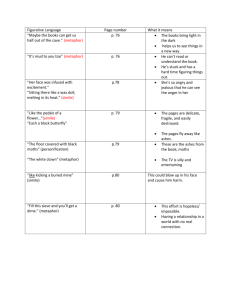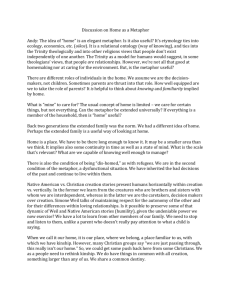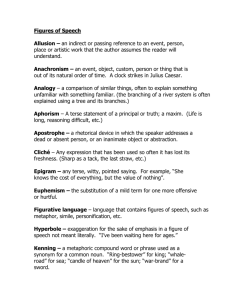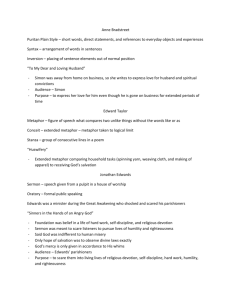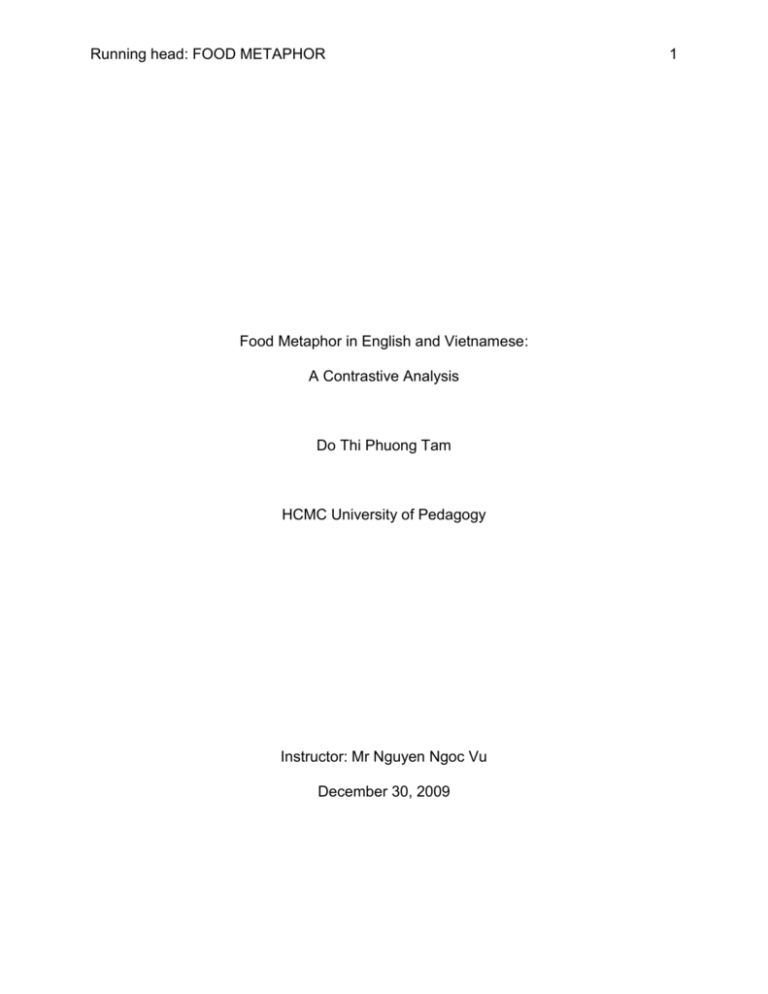
Running head: FOOD METAPHOR
Food Metaphor in English and Vietnamese:
A Contrastive Analysis
Do Thi Phuong Tam
HCMC University of Pedagogy
Instructor: Mr Nguyen Ngoc Vu
December 30, 2009
1
Running head: FOOD METAPHOR
2
Abstract
Adopting Lakoff and Johnson’s famous Conceptual Metaphor Theory, the present paper
looks into the set of correspondences of the two mappings: IDEA-AS-FOOD mapping
and SEX-IS-EATING mapping. Having the significant role in human survival and wellbeings, food is predicted to be an important source domain, based on which human
beings comprehend and talk about the world. The universal importance of food is
another reason for me to choose food metaphor as the ground to compare some
features of English and Vietnamese linguistic expressions, and hence, some cultural
features of the two nations as well. However, because of the limited scope, the content
of the present paper covers only two mappings mentioned above.
Keywords: Conceptual Metaphor Theory, mapping, domain, linguistics
expressions
Running head: FOOD METAPHOR
3
Introduction
For centuries, it has been taken for granted that metaphor is a mere figure of
speech which is used solely to embellish what can be otherwise conveyed in a plain,
literal way. However, recent studies on cognitive linguistics have revealed another
aspect of metaphor: metaphor as the illustration of the relationship between language
and human cognition (Grady, 2007). It is to say metaphor is not just a matter of
language; it fact, it is a matter of thought. Based on that theory, we can rely on
metaphor to explore the way we – human beings in general – perceive the world and
human stance in it. Also the comparison between common metaphors in one culture
with those in another can possibly reveal the way in which our neurobiology and
embodied experience determine our worldview; and hence, our use of language.
In many cultures, food has been associated with many other essential human
experiences, such as ideas, virtue, conduct, sexual desire, disposition, etc., due to its
prominent importance in human survival and pleasure (Berrada, 2007). Therefore,
looking at food metaphor in the two distinct languages – English and Vietnamese, I
hope to trace the similarity and differences in language back to distinctive features in
worldview and culture.
Background on Conceptual Metaphor Theory
Cognitive linguists emphasize that metaphors should not be considered as a
mere matter of language. It is actually a matter of thought. This view contradicts the
traditional belief which separate “literal and figurative language, with metaphor as a kind
of figurative language” (Lakoff, 1993). The view is said to be inspired by Reddy’s essay,
which by rigorous linguistic analysis and voluminous examples has pointed out
Running head: FOOD METAPHOR
4
“metaphor is a major and indispensable part of our ordinary, conventional way of
conceptualizing the world, and that our everyday behavior reflects our metaphorical
understanding of experience” (Lakoff, 1993). Lakoff and Johnson’s “Metaphors We Live
By” is also an important contribution to the contemporary understanding of metaphor.
According to Johnson, this conceptual view is also proved by the increasing number of
researches on metaphor in everyday language interaction, religion, science, philosophy,
law, among other domains of human thought (Berrada, 2007).
The most fundamental notion in conceptual metaphor theory (henceforth CMT) is
mapping (Grady, 2007). Metaphor can be, in fact, defined as “a cross-domain mapping
in the conceptual system”, which involves a tightly structured set of correspondences
(Lakoff, 1993). In his article, Lakoff has given a clear example of such mapping: the
LOVE-AS-A-JOURNEY mapping, in which there are ontological correspondences,
according to which entities in the domain of love (e.g., the lovers, their common goals,
their difficulties, the love relationship, etc.) correspond systematically to entities in the
domain of a journey (the travelers, the vehicle, destinations, etc.).
There are also some principles to bear in mind concerning CMT. One of them is
the “Invariance Principles,” which maintains that the mapping should not violate the
basic topological structure of the target domain (Grady, 2007). It guarantees that, “for
container schemas, interiors will be mapped onto interiors, exteriors onto exteriors, and
boundaries onto boundaries; for path-schemas, sources will be mapped onto sources,
goals onto goals, trajectories onto trajectories, and so on” (Lakoff, 1993). Besides the
Invariance Principle, which represents the systematicity of conceptual metaphor, the
asymmetrical directionality is also an important feature, strongly emphasized by Lakoff
Running head: FOOD METAPHOR
5
and Johnson and many cognitive linguists (Grady, 2007). It is to say that while a
particular conceptual metaphor is meaningful, its reverse, in most cases, is not possible.
We can easily understand what is meant by “I struggled to digest the news” but referring
to the act of digesting a pizza, for example, as an intellectual activity is obviously
unthinkable. The directionality of conceptual metaphor is not only a characteristic
feature but also evidence against the conventional view of metaphor as an implicit
simile. If metaphor has it most fundamental base as similarity, metaphorical substitution
should be possible in either way. However, it is not. The ground of metaphor is not
significantly on the similarity, but rather on the shared experience, which is also an
important principle of CMT. For example, it is hardly possible to identify the similarity
that account for the MORE-IS-UP metaphor; meanwhile it can be reasonably accounted
for by referring to everyday experience. Lakoff and Johnson explain that when we see a
pile of objects or liquid in a contained space, we easily relate the number of objects (or
amount of liquid) to the height of the pile (or of the liquid column). That is how the
MORE-IS-UP mapping is motivated. This experiential analysis does not merely explain
linguistic expressions but more significantly reveal the way human mind reflects the
world. (Grady, 2007)
Food Metaphor in English
IDEA-AS-FOOD Mapping
The name of a mapping, according to Lakoff, is just “a mnemonic for a set of
ontological correspondences that characterize a mapping.” Therefore, the proper way to
exploit the IDEA-AS-FOOD mapping is to look at it under other more specific mappings,
such as THE NEED FOR INFORMATION-IS-HUNGER, THINKING IS EATING,
Running head: FOOD METAPHOR
THINKING IS COOKING, UNDERSTANDING-IS-EATING, PROCESSING
INFORMATION-IS-DIGESTING, PROVIDING INFORMATION-IS-FEEDING
IDEAS ARE FOOD
(1) Anne has always read voraciously.
(2)That is food for thought.
THE NEED FOR INFORMATION-IS-HUNGER
(3) her hunger for knowledge
(4) the thirst for knowledge in Renaissance Italy
(5) She has an amazing appetite for knowledge.
(6) People seem to have an insatiable appetite for news of any kind.
THINKING IS EATING
(7) Let me chew it over for a few days.
(8) Amelia was chewing it over, undecided.
THINKING IS COOKING
(9) He's always coming out with these half-baked ideas which will never work.
(10) What we've got here is a half-baked proposal that still needs a great deal of
work.
UNDERSTANDING-IS-EATING
(11) I just can't swallow that claim.
(12) Let me stew over that for a while.
PROCESSING INFORMATION-IS-DIGESTING
(13) I struggled to digest the news.
(14) By the end of the day, I had a lot of new information to digest.
6
Running head: FOOD METAPHOR
7
(15) It took a while to digest the theory.
PROVIDING INFORMATION-IS-FEEDING
(16) She feeds the media with stories, which is a way of getting free advertising.
(17) US intelligence had been feeding false information to a KGB agent.
(18) The film put America's moviegoers into a feeding frenzy.
These mappings together with specific examples above prove that IDEA-ASFOOD is a popular and conventional metaphor in English. It evidences English people’s
conceptualization of ideas in terms of food, both of which are essential to human
survival and well-beings. Different as they may be, ideas and food are both involved the
process of being taken in either by the mind or by the body, which is possibly the
“experiential motivation” of this metaphor (Grady, 2007).
SEX-IS-EATING Mapping
The following narrative by Braine can be a good example of the mapping of sex
and eating:
I hadn’t fallen in love with her. And I wasn’t sex-obsessed.... It was simply
that I was an unmarried man with normal appetites. If you’re hungry and
someone’s preparing you a good meal, you’ll naturally angle for an
invitation. The meal was on the table, so to speak, and it was a long time
since I had eaten (Fernadez, 2008).
Based on this narrative, it can be postulated that within the SEX-IS-EATING
Mapping, sexual desire corresponds to appetite; sexual intercourse corresponds to
meal and sex partners correspond to food.
Food Metaphor in Vietnamese
Running head: FOOD METAPHOR
IDEA-AS-FOOD Mapping
Some English linguistic manifestations of this mapping can be translated into
Vietnamese without losing it cognitive content, for example:
(1)Anne has always read voraciously. – Anne vẫn luôn đọc ngấu đọc nghiến.
(11)I just can't swallow that claim. – Tôi thật không thể nuốt nổi câu nói đó.
(15) It took a while to digest the theory. – (Tôi) phải mất một lúc mới tiêu hóa
được lý thuyết ấy.
(16) She feeds the media with stories, which is a way of getting free advertising.
– Cô ta mớm chuyện cho giới truyền thông, như là một cách để được quảng cáo miễn
phí.
This suggests the possibility of the existence of the mapping in Vietnamese
language. Besides, a few Vietnamese idioms and expressions also bear the IDEA-ASFOOD metaphor. One of those is the sayings, “Ăn có nhai, nói có nghĩ” (literally, “chew
when you eat; think when you talk”) which implicitly conveys the association between
thinking and chewing. The expression “chậm tiêu” (literally, “slowly digesting”), used to
refer to dim-witted people, clearly reflects the UNDERSTANDING-IS-DIGESTING
mapping. Meanwhile, the THE NEED FOR INFORMATION-IS-HUNGER mapping is
manifested in the expression “đói chữ” (literally, hungry for literacy). Also, the idioms
“sôi kinh nấu sử” (literally, “boil the moral lessons, cook the history lessons”) indicates
the correspondence between cooking and learning process; however, this idiom is now
outdated, and hence, hardly ever used in normal everyday speech.
Based on these evidences, it can be said that the IDEA-AS-FOOD metaphor
does exist in Vietnamese language system. However, more evidence should be found
8
Running head: FOOD METAPHOR
9
in order to support the systematicity of the mapping in Vietnamese language as well as
Vietnamese people’s cognition.
SEX-IS-EATING Mappings
Many Vietnamese idioms reflect the SEX-IS-EATING mapping:
(19) Ông ăn chả, bà ăn nem. (literally, he has chả, she has nem1)
(20) Ăn phở bỏ cơm (literally, once you have phở, you will be too full to have
rice)
(21) No xôi thôi cơm (literally, once you have sticky rice, you will be too full to
have rice)
(22) Ăn bánh trả tiền (literally, you eat the cake, you pay the money)
(23) Ăn vụng không biết chùi mép (eating on the sly without cleaning your mouth)
Most of the expressions above use language in food domain to talk about issues
in sex domain, especially about extramarital affair. Like that in English, the SEX-ISEATING metaphor in Vietnamese idioms consists of a set of correspondences, i.e.
having sex corresponds to eating; extramarital affairs correspond to delicious dishes;
and sex within marriage corresponds to ordinary dish – rice. The idiom “Ông ăn chả, bà
ăn nem” describes the situation when both the man and his wife commit adultery. In
most cases, the two expressions “ăn phở bỏ cơm” and “no xôi thôi cơm” are understood
as the neglect of your spouse due to an extramarital affair. The expression “ăn bánh trả
tiền” again refers to eating (ăn bánh) as sexual intercourse, which is also reflected in the
last expression, “ăn vụng không biết chùi mép.”
1
“Chả” and “nem” are both delicious Vietnamese dishes.
Running head: FOOD METAPHOR
10
Juxtaposition of Food Metaphors in English with Those in Vietnamese and
Suggestion
The IDEA-AS-FOOD mapping is linguistically manifested in many languages,
including English, French, German, Chinese and Vietnam. It is quietly clear that the
English language has a systematic set of correspondences of this mapping. On the
contrary, the examples of the mapping in Vietnamese language system have not
provided strong evidence of the system of correspondences characterizing this
mapping. Further studies should be conducted focusing on the evidence of IDEA-ASFOOD mapping in Vietnamese in order to state certainly whether there is a conventional
system of correspondences of this mapping in Vietnamese.
The SEX-IS-EATING mapping is found to be manifested in both English and
Vietnamese. This probably suggests a common embodied experience conceptualized in
similar ways by the two nations. However, it is worth noting that while Vietnamese
idioms tend to distinguish between marital affair and adultery, English idioms do not
bother with this. Further studies on this issue can possibly shed more light into the
problem and hence identify the differences between the two cultures.
Besides IDEA-AS-FOOD mapping and SEX-IS-EATING mapping, the mapping
of human temperament and food is also worth consideration. Also, it can be interesting
to investigate the correspondences between eating and leading a particular lifestyle in
Vietnamese language system as eating is an integral part of Vietnamese culture.
Running head: FOOD METAPHOR
11
References
Ahrens, K., Chung, S. F. & Huang, C. (n.d.) Conceptual Metaphors: Ontology-based
Representation and Corpora Driven Mapping Principles. Retrieved December 28,
2009, from ACL Anthology website: http://acl.ldc.upenn.edu/W/W03/W031405.pdf
Berrada, K. (2007). Food Metaphors: A Contrastive Approach. Retrieved December 28,
2009, from the Metaphorik.de website: http://www.metaphorik.de/13/berrada.pdf
Fernández, E. C. (2008, Dec). Sex-Related Euphemism and Dysphemism: An Analysis
in Terms of Conceptual Metaphor Theory. ATLANTIS. Journal of the Spanish
Association of Anglo-American Studies, pp. 95–110. Retrieved December 28,
2009, from the Alanticjournal website: http://acl.ldc.upenn.edu/W/W03/W031405.pdf
Grady, J. E. (2007). Metaphor. In D. Geeraerts & H. Cuyckens (Ed.), The Oxford
Handbook of Cognitive Linguistics (pp.188-213). New York: Oxford University
Press.
Lakoff, G. (1993). Conceptual Metaphor: The Contemporary Theory of Metaphor. In D.
Geeraerts (Ed.), Cognitive Linguistics: Basic Readings (pp.188-213). Berlin:
Mouton de Gruyter.
Longman Dictionary of Contemporary English (3th ed.). (2004). Harlow, England:
Longman.



